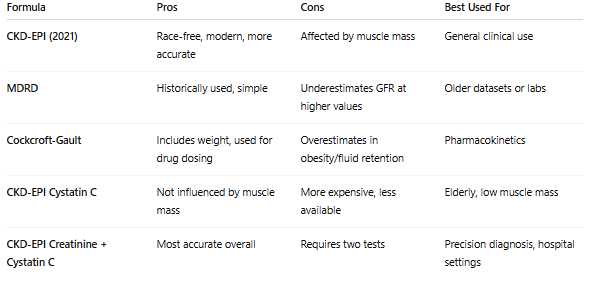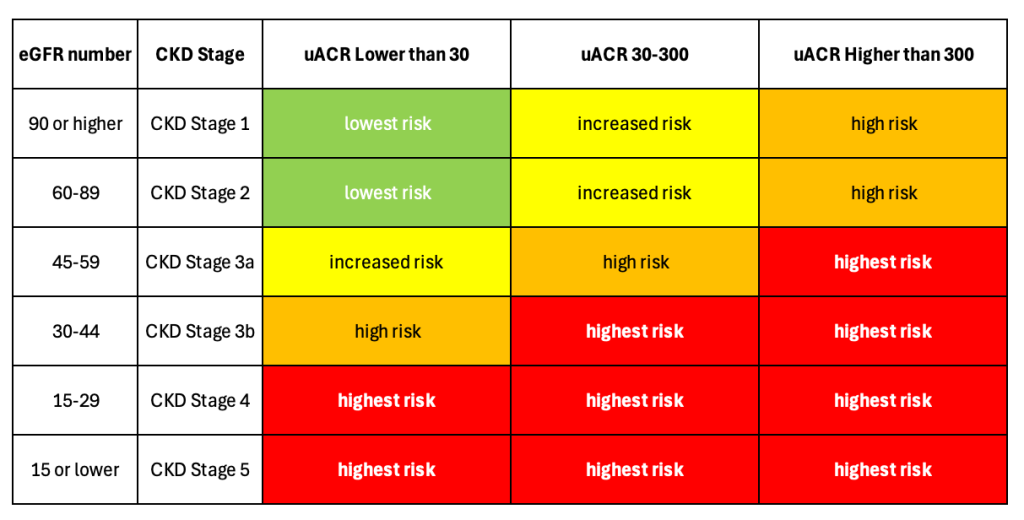Understanding eGFR: What It Really Means for Your Kidneys
Beyond the Numbers: Unlocking the Secrets of eGFR for Better Kidney Health
If you’ve ever stared at your eGFR number wondering what it really means, this newsletter is for you.
Let’s begin with the basics — and the big questions.
What Is eGFR?
eGFR, or estimated glomerular filtration rate, is one of the main markers used to assess how well your kidneys are filtering waste from your blood. But the keyword here is estimated. eGFR is not a direct measurement. It’s a calculation — a best guess — based on formulas that take into account your blood creatinine, cystatin C, age, sex, and sometimes race or body size.
The Main eGFR Formulas
There are several equations used to estimate kidney function:
CKD-EPI (Chronic Kidney Disease Epidemiology Collaboration):
For Creatinine
For Cystatin C
MDRD (Modification of Diet in Renal Disease)
Cockcroft-Gault
Each one uses slightly different variables and assumptions, and they don’t all give the same result. The CKD-EPI formula (especially the 2021 race-free version) is now considered the most accurate in many situations, even better when using both formulas Creatinine + Cystatin C (you need to perform both tests)
Which Formula Is Best?
You can use the National Kidney Foundation's eGFR Calculator. There you'll also find the formulas used.
Criteria for CKD
Below I leave the criteria used by most doctors and also by the National Kidney Foundation
Either of the following present for > 3 months
Decreased eGFR <60 ml/min/1.73 m2
Markers of kidney damage
(one or more)Albuminuria (ACR ≥ 30 mg/g)
Urine sediment abnormalities
Electrolyte and other abnormalities due to tubular disorders
Abnormalities detected by histology
Structural abnormalities detected by imaging
History of kidney transplantation
My personal view
I have two personal observations on this criteria:
Since CKD is only officially diagnosed when eGFR falls below 60 ml/min/1.73 m², stage 2 kidney disease often gets overlooked. As a result, many doctors fail to inform patients, even when they’re in this early stage.
I’ve encountered several individuals with an eGFR under 60 ml/min/1.73 m², but all their other tests, including the Albumin-to-Creatinine Ratio (ACR), come back normal. According to the current criteria, this isn't considered CKD. However, eGFR represents a snapshot of kidney function at that particular moment — it shows how much the kidneys are filtering at that time. On the other hand, the ACR provides a longer-term view, indicating the potential for kidney deterioration in the future. The issue arises when a low eGFR is caused by an acute kidney injury, which could happen due to medications, surgeries, infections, or other factors. In these cases, the kidneys might not fully recover, leading to permanent damage to some nephrons. Even though the ACR might not signal immediate risk, it fails to account for the acute injury that could have led to lasting damage. This can result in patients not being properly warned or monitored for potential future complications.
CKD Heat Map
The chart below helps monitor the risk of kidney disease progression by combining eGFR and ACR values.
Why eGFR Can Be Misleading
Even with the best formulas, eGFR is still an estimate, and your values can fluctuate due to:
Dehydration or overhydration
High-protein meals
Supplements or medications (like NSAIDs, ACE inhibitors)
Lab variability
Muscle mass differences
This is why doctors look at trends over time, not single values.
Can eGFR Detect CKD With 100% Accuracy?
No. There is no test today that can diagnose CKD with 100% certainty. eGFR must be interpreted:
Over time (minimum 3 months of data)
Alongside urinalysis (proteinuria, albumin, ACR)
In the context of symptoms, comorbidities, and other lab values
Metabolomics: The Future of GFR Estimation?
At MetaSano, we are researching how metabolomics may help predict kidney function more precisely.
What is metabolomics?
It’s the study of small molecules — or metabolites — in your blood or urine. These molecules reflect real-time metabolic activity in your cells. Unlike creatinine, which can take time to rise, certain metabolites may indicate stress or early dysfunction before damage becomes irreversible.
We believe metabolomics could help detect kidney disease earlier and guide personalized nutrition and lifestyle plans — tailored to each person’s biochemical fingerprint.
Takeaway
eGFR is one of the best tools we have — but it’s not perfect. Knowing which formula was used, what might be influencing your results, and how to monitor trends is critical for informed, proactive kidney care.
With the right knowledge, tools, and science, you can take control of your lab results — and your health.
Not using MetaSano yet?
Join the food-as-medicine movement and take control of your kidney health.
👉 Download MetaSano now
Our newsletter comes out every Sunday and Wednesday, bringing you insights, tools, and personal experiences to help you live better with CKD.
With care,
Ewerton Lopes - Living with CKD since 2016
CEO of MetaSano
Integrative Nutrition Specialist
Kidney Health Coach
Member of the Quebec Nephrology Society
Gerontologist



Can your age or the fact you were born with one kidney effect these numbers at all